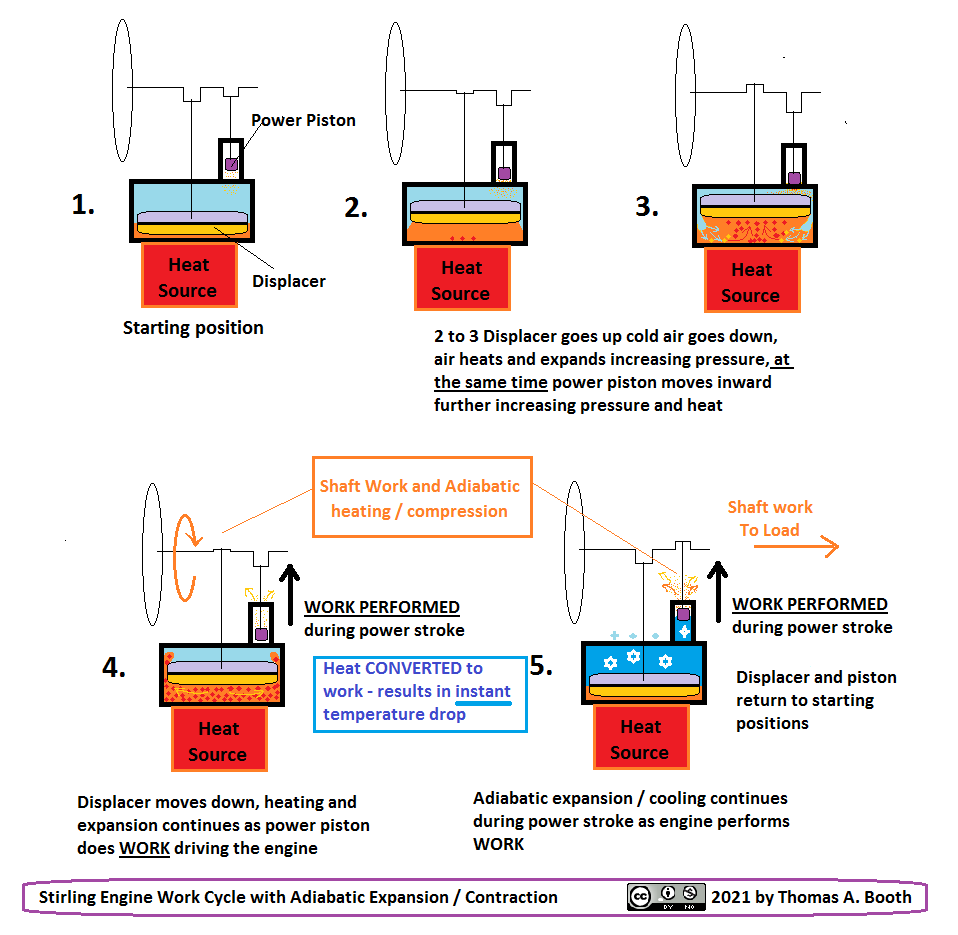Nobody wrote: ↑Sun Oct 10, 2021 8:24 am
(...).
First answering the opening post. No a Stirling engine can't cool the cold side at the same time it is running. If an engine is driven, in the same direction as it drives, the hot side will cool, as demonstrated in the Philip's video.
There are four functions mentioned in the video:
1. Heat engine running forward, hot head, head cooling
2. Heat pump driven backwards, heating head, until hot.
3. Cold pump, refrigerator, driven forwards, cooling head, until cold.
4. Cold engine running backwards, cold head. Head warming.
In other words, to heat the head it needs to be driven the opposite of how it drives.
To cool the head it also needs to go the opposite way of work direction.
This all says nothing of the base where the base is kept close to the water bath temperature. The opposing thermal sink.
I'm not suggesting that the heat/energy flow is being reversed in order to cool the sink.
There is the hot side of the engine and the cold side between which, in an LTD type engine, the displacer moves back and forth.
Simultaneously the piston is responding and the internal pressure and temperature are fluctuating.
There is one other thing happening that frequently escapes many peoples attention. Heat as "kinetic energy" is being transfered from the gas molecules to the piston.
Let's assume some actual load on the engine, somewhere for this "converted" heat into "work" to go -> outside the "system" under consideration.
What it looks like to me is that the piston is like a baseball. There are two batters knocking the ball back and forth between each other. There is some mechanism attached to the ball that serves to extracted mechanical work from the ball/piston.
One "batter" is atmospheric pressure knocking the ball in one direction, the other is heat input knocking the ball back in the opposite direction.
You could say one batter is much stronger than the other but both are contributing some energy to this "system" to keep the ball in motion and to keep generating the kinetic work output.
In other words, Both sides of the engine are experiencing cooling, or transfer of heat into the system as heat and out of the system as work.
The role of the displacer, if it is used, is not to assist the transport of heat through the engine. Rather, it helps to balance and regulate the internal temperature and pressure (and work output) in such a way that energy is always moving in the direction high pressure -> driving piston -> work output.
The displacer introduces heat which "bats" the piston one way, then as the gas expands and drives the piston and the gas undergoes adiabatic cooling, converting the added heat into work output, the displacer "cuts off" heat input, allowing the temperature of the gas to continue cooling by adiabatic expansion as the piston continues traveling outward due to stored momentum, in the piston itself and flywheel, if used.
Atmospheric pressure then "bats" the piston back in the other direction and, in the case where a magnetic "free piston" and linear alternator are used, (or even where it is not used) additional heat to work (mechanical and/or electrical) conversation takes place.
If, but only if, TOO MUCH HEAT is introduced, the "excess" might need to be dumped, the engine overheating, but this can be resolved by load balancing Heat input regulated so as to match work output, and to compensate for loses due to friction.
The lingering idea, stemming all the way back to Carnot and company, that heat MUST be transfered to the cold sink is IMO erroneous.
Yes, it often happens that excess heat is supplied. Stirling engines are very frugal and this is all too easy.
I posted this diagram earlier to help illustrate what I believe actually takes place inside a Stirling engine, or can take place, where there is well regulated load balancing. (Or good load balancing just by "coincidence" or design)

- Stirling_engine-cooler_by_Tom_Booth_CC.png (55.61 KiB) Viewed 3017 times
This is not a proposal for some NEW kind of Stirling engine. Just my own insight into how a Stirling engine actually functions already, or should function
Knowing this, it may be possible to make certain modifications or changes to optimize what is already a reality, but if it is considered that these heat engines work by throwing away heat into the sink, efforts to improve Stirling engine performance to compete with IC engines is not likely to succeed.
It is only by having a clear understanding of what is going on in these engines that some improvements might be made, or otherwise it might happen only by some fluke or accident.
I really think heat energy conversion could be on a par with other types of energy conversion, like electricity to heat, or electric motors which can be 85% to 90+% energy efficient.
But we need to stop designing engines based on the assumption that having excess heat and then throwing that excess away is somehow essential.